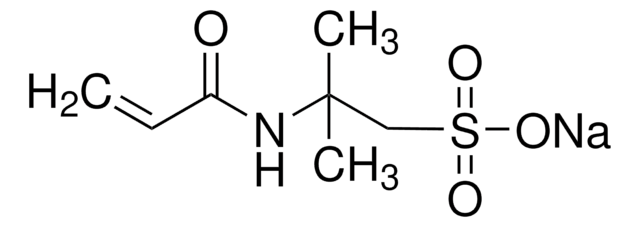If this product has an expiration or retest date, it will be shown on the Certificate of Analysis (COA, CofA). If there is no retest or expiration date listed on the product's COA, we do not have suitable stability data to determine a shelf life. For these products, the only date on the COA will be the release date; a retest, expiration, or use-by-date will not be displayed.
For all products, we recommend handling per defined conditions as printed in our product literature and website product descriptions. We recommend that products should be routinely inspected by customers to ensure they perform as expected.
For products without retest or expiration dates, our standard warranty of 1 year from the date of shipment is applicable.
For more information, please refer to the Product Dating Information document: https://www.sigmaaldrich.com/deepweb/assets/sigmaaldrich/marketing/global/documents/449/386/product-dating-information-mk.pdf
Wichtige Dokumente
278424
Poly(vinylsulfonsäure, Natriumsalz) -Lösung
30-40 wt. % in H2O, technical grade
Synonym(e):
PVSA
Größe auswählen
About This Item
Empfohlene Produkte
Qualität
technical grade
Qualitätsniveau
Form
liquid
Konzentration
30-40 wt. % in H2O
Brechungsindex
n20/D 1.389
Dichte
1.267 g/mL at 25 °C
SMILES String
[Na]OS(=O)(=O)C=C
InChI
1S/C2H4O3S.Na/c1-2-6(3,4)5;/h2H,1H2,(H,3,4,5);/q;+1/p-1
InChIKey
BWYYYTVSBPRQCN-UHFFFAOYSA-M
Verwandte Kategorien
Anwendung
- Bei der Herstellung von superabsorbierendem Semi-IPN (interpenetrierendes Polymernetzwerk)-Hydrogel.
- Als fester Elektrolyt für die Protonenleitung bei der Herstellung eines vollmassiven Superkondensators.
- Als Kristallisationskontrollmittel bei der Herstellung von hochwertigen Kristallen von porösen Koordinationspolymeren (CP). PVSA reguliert nicht nur die Größe und Struktur der Kristalle, sondern auch deren bevorzugte Orientierung, was zu einer CP-Kanalausrichtung im Pulverschüttungszustand führt.
Signalwort
Warning
H-Sätze
Gefahreneinstufungen
Eye Irrit. 2 - Skin Irrit. 2 - STOT SE 3
Zielorgane
Respiratory system
Lagerklassenschlüssel
10 - Combustible liquids
WGK
WGK 3
Persönliche Schutzausrüstung
Eyeshields, Gloves, type ABEK (EN14387) respirator filter
Hier finden Sie alle aktuellen Versionen:
Besitzen Sie dieses Produkt bereits?
In der Dokumentenbibliothek finden Sie die Dokumentation zu den Produkten, die Sie kürzlich erworben haben.
Kunden haben sich ebenfalls angesehen
Artikel
Recently, layer-by-layer (LbL) assembly has emerged as a versatile, gentle and, simple method for immobilization of functional molecules in an easily controllable thin film morphology.1,2 In this short review, we introduce recent advances in functional systems fabricated by using the mild, yet adaptable LbL technique.
We present an article that discusses two applications in particular; first, using these layers as polyelectrolyte membranes to control permeability.
-
How can I determine the shelf life / expiration / retest date of this product?
1 answer-
Helpful?
-
-
How is shipping temperature determined? And how is it related to the product storage temperature?
1 answer-
Products may be shipped at a different temperature than the recommended long-term storage temperature. If the product quality is sensitive to short-term exposure to conditions other than the recommended long-term storage, it will be shipped on wet or dry-ice. If the product quality is NOT affected by short-term exposure to conditions other than the recommended long-term storage, it will be shipped at ambient temperature. As shipping routes are configured for minimum transit times, shipping at ambient temperature helps control shipping costs for our customers. For more information, please refer to the Storage and Transport Conditions document: https://www.sigmaaldrich.com/deepweb/assets/sigmaaldrich/marketing/global/documents/316/622/storage-transport-conditions-mk.pdf
Helpful?
-
-
What causes the difference between the yellow and amber colors of this product?
1 answer-
The quality specification for this item is only a residue on evaporation and appearance (color and form) assay for this technical grade product. Differences in color could be from numerous causes such as overall polymer composition, color perception, or appearance of raw material. It is not uncommon for the poly(styrenesulfonic acid sodium salt) to have color variations.
Helpful?
-
-
Hello, Just to confirm does the concentration of PVS vary from 30-40% in this raw material? Does 'Residue on evaporation' refer to the concentration of just PVS and not any impurities also in the raw material? I need to know the concentration of PVS.
1 answer-
Residue on evaporation refers to any solid material remaining after evaporating the water away. This value does not take into account potential impurities present in addition to the Poly(vinylsulfonic acid, sodium salt). Therefore, the concentration may vary slightly from the value provided on the lot-specific Certificate of Analysis.
Please access the link below to download a Certificate:
https://www.sigmaaldrich.com/product/aldrich/278424#product-documentationHelpful?
-
-
What is the pKa of this Poly(vinylsulfonic acid?
1 answer-
The pKa value is not determined for this product.
Helpful?
-
-
What is the average molecular weight of the SIgma Poly(vinylsulfonic acid, sodium salt)?
1 answer-
The molecular weight between 2000 and 5000 g/mol.
Helpful?
-
Active Filters
Unser Team von Wissenschaftlern verfügt über Erfahrung in allen Forschungsbereichen einschließlich Life Science, Materialwissenschaften, chemischer Synthese, Chromatographie, Analytik und vielen mehr..
Setzen Sie sich mit dem technischen Dienst in Verbindung.












